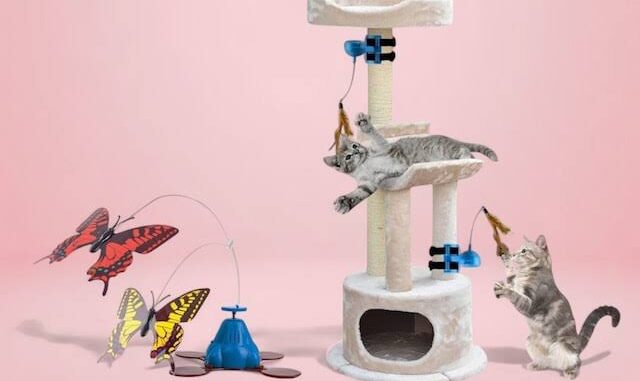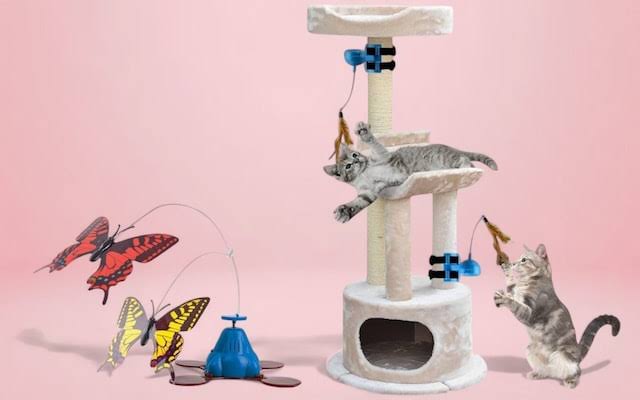
The Best Cat Toys for Active Felines: Cats are natural hunters. Even the fluffiest lap cat still carries strong instincts from their wild ancestors chasing, pouncing, stalking, and leaping. But in a modern home, indoor cats often lack the physical and mental stimulation needed to stay healthy and happy.

That’s where interactive cat toys come in. The best toys not only keep cats active and engaged but also help prevent boredom, anxiety, and destructive behavior. In this guide, we’ll explore the top cat toys for active felines, categorized by play style, age, and engagement level.
Why Toys Are Essential for Active Cats
Before diving into toy recommendations, it’s important to understand why play is crucial:
- Physical Exercise: Reduces obesity, supports healthy joints, and strengthens muscles.
- Mental Stimulation: Prevents boredom and related stress behaviors like overgrooming or aggression.
- Bonding: Interactive play strengthens your relationship with your cat.
- Instinct Fulfillment: Satisfies natural hunting urges in a safe, indoor environment.
Types of Cat Toys (and Why They Work)
1. Interactive Laser Toys
Best For: High-energy cats who love chasing
Laser pointers provide fast-paced, unpredictable movement that cats find irresistible. Automatic laser toys, such as the PetSafe Bolt or FroliCat Multi-Laser, offer hands-free stimulation by randomly directing a beam across the room.
Pro Tip: Always end play by switching to a physical toy your cat can “catch” to avoid frustration.
2. Wand Toys and Teasers
Best For: Bonding and engaging multiple senses
These mimic birds or mice and are fantastic for leaping, pouncing, and chasing. Look for durable wands with feather, ribbon, or bell attachments like:
- Da Bird
- GoCat Teaser
- Jackson Galaxy Air Prey Wand
Benefits:
- Mimics real prey movement
- Builds trust and excitement during play
- Easily customizable with different attachments
3. Puzzle Feeders & Treat Dispensers
Best For: Intelligent cats or food-motivated felines
These toys combine play with problem-solving and rewards. Excellent examples include:
- Catit Senses 2.0 Food Tree
- Doc & Phoebe’s Indoor Hunting Feeder
- Trixie 5-in-1 Activity Center
Benefits:
- Slows down eating
- Keeps cats mentally sharp
- Reduces boredom and destructive behavior
4. Motion-Activated Toys
Best For: Independent play when you’re not home
Battery-operated toys like the PetDroid Boltz, Hexbug Mouse, or SmartyKat Hot Pursuit move unpredictably to mimic real prey. Some respond to movement, sound, or touch.
Features to Look For:
- Randomized movement patterns
- Auto shut-off for battery saving
- Quiet operation for skittish cats
5. Catnip Toys
Best For: Sensory play and solo fun
Cats affected by catnip (about 70–80%) go wild for these toys. Great options include:
- Yeowww! Catnip Banana
- KONG Refillable Catnip Toys
- Petstages Fresh Breath Mint Stick
Variations:
- Silvervine (alternative for cats immune to catnip)
- Valerian root toys
Note: Always monitor new catnip toys to ensure a positive reaction.
READ ALSO: Best Puzzle Toys for Dogs to Stimulate Their Minds
6. Ball Track and Rolling Toys
Best For: Solo play and kitten training
Circular tracks with balls (like the Petstages Tower of Tracks) or motorized rolling balls keep cats occupied with movement and noise. They trigger a cat’s natural chase response.
Benefits:
- Encourages solo play
- Safe for all ages
- Can be used on carpets or hardwood floors
7. Climbing Trees and Activity Centers
Best For: Physical stimulation and territorial behavior
Though not technically “toys,” cat trees, tunnels, and activity centers encourage jumping, climbing, scratching, and hide-and-seek play. Look for:
- Multiple tiers
- Integrated toys
- Cozy hideouts
Combine with hanging toys for double stimulation.
8. Tunnels and Crinkle Toys
Best For: Ambush play and hide-and-seek lovers
Collapsible crinkle tunnels add auditory fun. Add balls or wand toys at one end to simulate prey escaping.
Popular choices:
- Frisco Crinkle Play Tunnel
- SmartyKat Crackle Chute
9. Electronic Smart Toys (AI/Autonomous)
Best For: Tech-savvy pet parents and independent cats
Toys like the Cheerble Wicked Ball or VARRAM Pet Fitness Robot offer AI-based movement patterns, obstacle detection, and auto-charging.
Features:
- App control
- Movement sensors
- Rechargeable battery
These advanced toys keep your cat stimulated even during long workdays.
10. DIY and Budget-Friendly Options
Great For: Creative cat parents or quick boredom fixes
Some of the best cat toys are free or homemade:
- Cardboard boxes and paper bags
- DIY feather wands
- Bottle caps or ping pong balls
- Toilet paper rolls filled with treats
These can be rotated often to keep interest fresh.
How to Rotate and Maintain Toys
- them weekly to avoid overstimulation.
- Introduce “new” toys by storing some out of sight and reintroducing later.
- Clean toys regularly—especially if they’re electronic, fabric, or chewed.
Tip: Use toy boxes for organization and make “toy time” part of daily routine.
Toy Safety Guidelines
- Supervise your cat with new toys, especially those with strings, feathers, or batteries.
- Replace worn or broken toys to avoid ingestion risks.
- Avoid toxic materials (cheap plastic, sharp edges, or small parts).
FAQs
How many toys should an active cat have?
An active cat benefits from 5–10 different types of toys, with 2–3 in rotation at a time. Focus on variety—chase toys, pounce toys, puzzle toys, and solo-play options.
Do cats get bored of toys?
Yes. Cats can lose interest quickly, especially in static toys. Rotating toys weekly and varying play types helps maintain engagement.
Is laser play safe for cats?
Laser toys are safe when used properly:
- Never shine directly in their eyes.
- End sessions with a toy they can “catch” to avoid frustration.
- Keep sessions short and positive.
Are electronic toys better than traditional ones?
Not always. Electronic toys are great for solo play and mental stimulation, but interactive play (with wands or teasers) builds stronger bonds and fulfills prey instincts more effectively.
What if my cat doesn’t like toys?
Try different styles:
- Use treats or catnip as motivation.
- Experiment with toys that use sound, light, or smell.
- Some cats prefer boxes or tunnels to flashy electronics.
You may also need to initiate play consistently to spark interest.
Can toys help with cat aggression or anxiety?
Absolutely. Regular, structured play:
- Releases pent-up energy
- Mimics hunting sequences (stalk → chase → catch → kill → eat → groom → sleep)
- Reduces aggression, misbehavior, and anxiety
How much playtime do cats need daily?
Active adult cats should get at least 20–30 minutes of active play per day, split into 2–3 sessions. Kittens or high-energy breeds may need more.
What are signs that my cat is overstimulated?
Watch for:
- Tail lashing
- Sudden biting or scratching
- Ears pinned back
- Dilated pupils
If you see these signs, give them a break and space to decompress.
Are catnip toys safe every day?
Yes but limit sessions to a few times per week to prevent desensitization. Rotate between catnip, silvervine, and valerian for variety.
Are all cats playful by nature?
Most are but their play preferences vary. Some prefer chasing, others batting, hiding, or pouncing. Tailor toys to your cat’s instincts and energy level.
Leave a Reply
You must be logged in to post a comment.